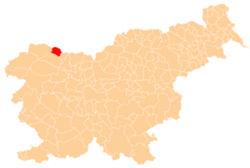Blejska Dobrava
| Blejska Dobrava | |
|---|---|
|
Postcard of Blejska Dobrava | |
 Blejska Dobrava Location in Slovenia | |
| Coordinates: 46°24′45″N 14°5′41″E / 46.41250°N 14.09472°ECoordinates: 46°24′45″N 14°5′41″E / 46.41250°N 14.09472°E | |
| Country |
|
| Traditional region | Upper Carniola |
| Statistical region | Upper Carniola |
| Municipality | Jesenice |
| Elevation | 582 m (1,909 ft) |
| Population (2002) | |
| • Total | 977 |
| [1] | |
Blejska Dobrava (pronounced [ˈbleːi̯ska dɔˈbɾaːʋa]) is a settlement in the Municipality of Jesenice, in the Upper Carniola region of Slovenia. It is one of the oldest villages in the area, attested from the 12th century,[2] and is located at the base of the Mežakla Plateau, on a series of river terraces between the right bank of the Sava Dolinka and the Radovna River as it exits the Vintgar Gorge. Its name (literally, 'Bled Dobrava') reflects its original connection to the nearby town of Bled.
Once predominantly agricultural, it has partially urbanized under the influence of industry from the nearby municipal seat of Jesenice. There is a manufacturing plant, tracing its roots back to a prewar electrode factory, as well as two smaller industrial facilities. The Vintgar hydroelectric plant on the Radovna stands nearby, as does the scenic Vintgar Gorge, a popular tourist attraction.
The Koroška Bela Primary School, in the village of Koroška Bela across the Sava Valley, operates a branch location in Blejska Dobrava.
The settlement is located on the road connecting the Upper Sava Valley to Bled (through the hamlet of Poljane in Spodnje Gorje). The Jesenice–Bohinj railroad also passes through, stopping at a small station. The Jesenice municipal cemetery is located nearby.
St. Stephen's Church
St. Stephen's Church (Slovene: Cerkev svetega Štefana), dedicated to Saint Stephen, was originally gothic, with a rectangular nave and pentagonal presbytery, but was rebuilt in 1743 in the Baroque style. A wall around the church encloses the old, abandoned graveyard, with some of the older graves still marked, including the grave of two sisters (Katra and Jera) of the poet France Prešeren, built into the church's outside wall.
See also
References
External links
-
 Media related to Blejska Dobrava at Wikimedia Commons
Media related to Blejska Dobrava at Wikimedia Commons - Blejska Dobrava on Geopedia

